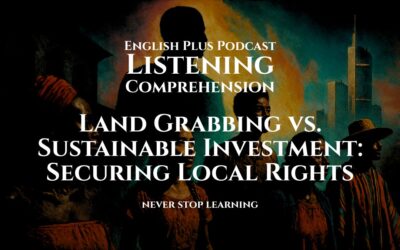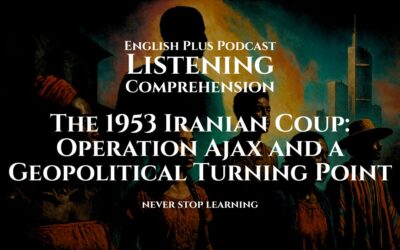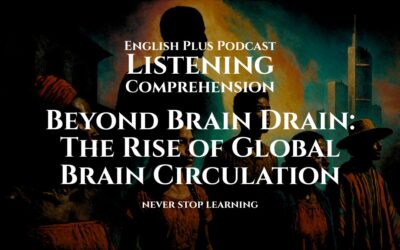Sharpen Your Listening Skills for Exam Success
Welcome to your listening comprehension practice session. The audio you are about to hear is an academic lecture, similar in style and difficulty to what you might encounter in international exams like the TOEFL or IELTS. The key to success in these tests isn’t just understanding English; it’s about active, strategic listening.
Here are a few tips to keep in mind:
- Predict and Prepare: Before you listen, look at the topic: “Global Perspectives on Religious Freedom.” This is a complex topic. Think of related words (law, human rights, belief, state, secular, worship). This warms up your brain and helps you anticipate the content.
- Listen for Different Viewpoints: A topic like this often involves multiple perspectives. Listen for how the speaker presents different models or ideas. Are they comparing them? Contrasting them?
- Follow the Signposts: Speakers use “signposting language” to guide you. Listen for words and phrases like “On one end of the spectrum,” “In contrast,” “A clear example is,” and “In summary.” These signal a shift in topic, a comparison, an example, or a conclusion.
- Don’t Panic: You will almost certainly hear words you don’t know. Don’t get stuck on them. Note the word if you can, but focus on understanding the overall meaning of the sentence from the context. You can often infer the meaning.
Now, prepare to listen to the lecture on Global Perspectives on Religious Freedom.
Listening Audio
Listening Transcript: Please do not read the transcript before you listen and answer the questions.
Good afternoon. Today’s lecture will navigate the complex and often contentious landscape of religious freedom from a global, legal perspective. At its core, freedom of religion or belief is a fundamental human right. It is enshrined in foundational international documents, most notably Article 18 of the Universal Declaration of Human Rights, which states that everyone has the right to freedom of thought, conscience, and religion. This right includes the freedom to change one’s religion or belief, and freedom, either alone or in community with others and in public or private, to manifest this religion or belief in teaching, practice, worship, and observance. However, the interpretation and application of this principle vary dramatically across the globe, creating a diverse and sometimes contradictory tapestry of national laws and cultural norms.
To understand these variations, it’s useful to consider a spectrum of state-religion relationships. On one end of this spectrum, you have states with an official or established religion, often referred to as a state religion. In such countries, the state formally endorses a specific faith. This endorsement can range from purely symbolic, with minimal impact on the daily lives of citizens of other faiths, to deeply integrated, where religious law, or a version of it, heavily influences the nation’s legal and political systems. For example, in countries like England, the Church of England is the established church, but this has evolved into a largely ceremonial role with robust protections for other faiths. In contrast, in some nations, the state religion is intertwined with national identity and law, posing significant challenges for religious minorities.
On the opposite end of the spectrum lies the model of state secularism. Secularism, in this context, is the principle of separating governmental institutions and persons mandated to represent the state from religious institutions and religious dignitaries. A secular state purports to treat all its citizens equally, regardless of their religious beliefs, and avoids giving preferential treatment to any one religion. France is a prominent example of a strictly secularist model known as “laïcité,” where religion is strongly relegated to the private sphere. This means, for instance, that overt religious symbols are banned in public schools and for public servants. Proponents argue this protects the state from religious interference and protects citizens from religious coercion. However, critics contend that this strict model can itself infringe upon individual freedom of expression, particularly for minorities whose religious identity is visibly expressed.
Between these two poles, most countries exist in a middle ground, often described as “accommodationalist” or “pluralistic.” These states have no official religion but actively accommodate and engage with various religious groups. The United States provides a classic example. The First Amendment to its Constitution prohibits the government from establishing a religion, yet it also guarantees the “free exercise” of religion. This has led to a vibrant, if often litigious, public square where different religious groups coexist, advocate for their interests, and contribute to public life. This model acknowledges that religion is a significant aspect of many citizens’ lives and seeks to create a framework where multiple belief systems can flourish without state endorsement.
The real challenge, for any system, arises when the right to religious freedom appears to clash with other fundamental rights. What happens when a religious practice is seen to discriminate against women? Or when freedom of speech is used to criticize or mock religious beliefs, leading to accusations of blasphemy? These are not simple questions, and different legal traditions provide different answers. International human rights law provides a framework, suggesting that freedom to manifest one’s religion can be limited, but only if such limitations are prescribed by law and are necessary to protect public safety, order, health, or morals, or the fundamental rights and freedoms of others. This “proportionality test” is the fulcrum upon which many legal battles over religious freedom balance.
In conclusion, religious freedom is not a monolithic concept. Its expression is contingent upon history, culture, and legal philosophy. From state-endorsed religions to strictly secular republics and pluralistic societies, each model presents its own unique strengths and inherent tensions. Understanding these global perspectives is crucial not only for legal scholars and diplomats but for any citizen of our increasingly interconnected world, as we collectively grapple with the profound question of how to live together with our deepest differences.
Listening Quiz
Keywords & Phrases
Contentious
This adjective describes something that is likely to cause an argument or disagreement.
How we used it: “…navigate the complex and often contentious landscape of religious freedom…” This means the topic is one that people frequently argue about.
Enshrined
This verb means to set down a right or belief in a formal and protected way, as if in a holy place. It is often used for laws and constitutions.
How we used it: “It is enshrined in foundational international documents…” This means the right to religious freedom is formally protected in those important documents.
Purports
This verb means to appear or claim to be or do something, especially falsely; to profess. It often carries a slight sense of skepticism.
How we used it: “A secular state purports to treat all its citizens equally…” This suggests that this is the stated goal or claim of a secular state, though the reality might be debated.
Relegated
This verb means to assign to an inferior rank or position; to demote.
How we used it: “…where religion is strongly relegated to the private sphere.” This means religion is moved out of the public domain and confined to a less prominent, private role.
Contend
This is a formal verb for “to argue” or “to state something as a position in an argument.”
How we used it: “However, critics contend that this strict model can itself infringe upon individual freedom…” This introduces the argument made by those who oppose the strict secular model.
Litigious
This adjective describes a tendency to resort to lawsuits to settle disputes.
How we used it: “This has led to a vibrant, if often litigious, public square…” This means that while the US model allows for religious expression, it also leads to many court cases over religious issues.
Blasphemy
This is the act or offense of speaking sacrilegiously about God or sacred things; profane talk.
How we used it: “…leading to accusations of blasphemy.” This refers to the charge that someone has deeply insulted a religion or its figures.
Fulcrum
The point on which a lever rests or is supported and on which it pivots. It is used metaphorically to mean a central or essential thing.
How we used it: “This ‘proportionality test’ is the fulcrum upon which many legal battles over religious freedom balance.” This means the test is the central, pivotal point that decides the outcome of these legal cases.
Monolithic
This adjective means formed of a single large block of stone. Metaphorically, it means large, powerful, and uniform or indivisible.
How we used it: “…religious freedom is not a monolithic concept.” This means it’s not a single, uniform idea but has many different forms and interpretations.
Contingent upon
This phrase means “depending on” or “conditional on.”
How we used it: “Its expression is contingent upon history, culture, and legal philosophy.” This means the way religious freedom looks in a country depends on these factors.










0 Comments